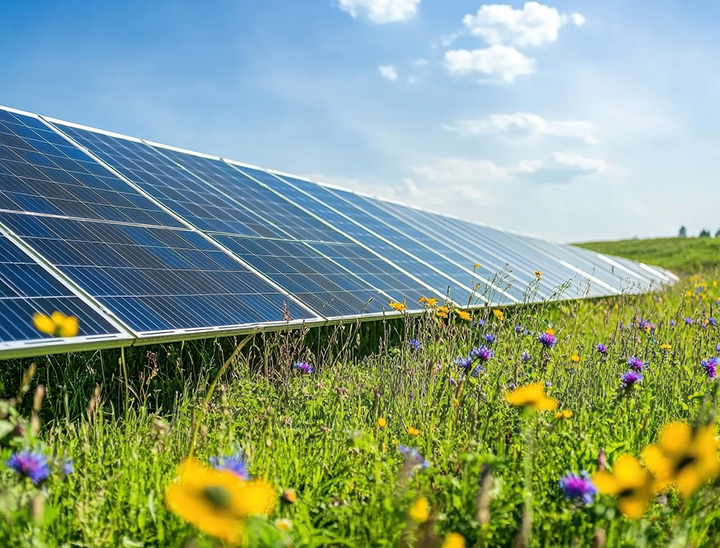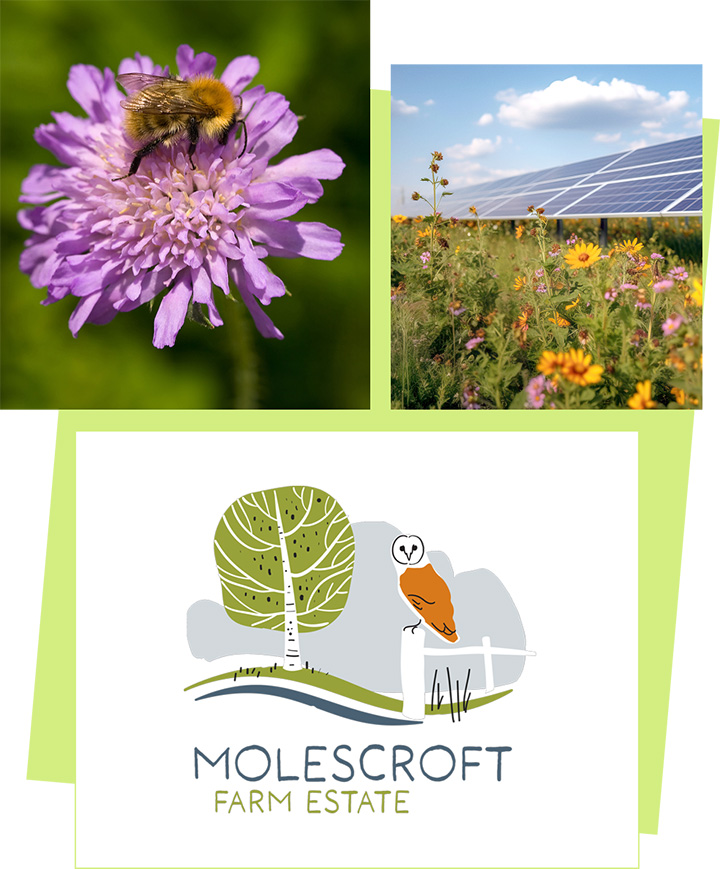Why we need solar energy
Helping to urgently reduce our reliance on fossil fuels
The effects of climate change are becoming increasingly visible – from rising global temperatures to extreme weather events. In the UK, we are already experiencing more frequent and severe flooding and heatwaves, all of which place added strain on communities, public services and the natural environment.
To tackle this, the UK has committed to reaching net zero carbon emissions by 2050. Meeting this goal means urgently reducing our reliance on fossil fuels and increasing the use of clean, renewable energy sources.
Solar energy is a vital part of the solution, offering one of the cheapest and most reliable sources of renewable electricity.

Key benefits
Supporting clean, green energy together as a community
By investing in solar farms like this one, we can:
- Cut greenhouse gas emissions and slow the pace of climate change.
- Protect future generations by limiting environmental damage.
- Generate clean, homegrown energy, reducing dependence on imported fossil fuels.
- Improve our energy security to protect against geopolitical conflict.
Our plans at Molescroft Farm perfectly align with the farm’s long-standing commitment to regenerative farming, a practice they’ve embraced since 2011. This proposal is focused on the least productive land, ensuring it complements and does not undermine the farm’s existing operations. The move to renewables is already underway and projects like Molescroft Solar Farm are essential in building a cleaner, more resilient energy system.

FAQs
Your questions answered
Why has Enray selected this site?
A thorough site selection process has been undertaken to ensure that only the most appropriate land was chosen for the proposed solar farm. Through a comprehensive site search exercise, it has been identified that the Molescroft Farm site represents the most suitable location to accommodate the development.
To deliver the required energy output of 40MW, the site needed to be of a certain scale and located within close proximity to the agreed point of connection (PoC) to the national electricity grid. The Molescroft Farm site meets these criteria, offering sufficient land to support the necessary quantum of solar panels while also being well located in relation to existing grid infrastructure situated within the site.
A significant portion of the site is classified as Grade 3b agricultural land — moderate quality and not considered best and most versatile. The land is also frequently affected by surface water flooding and standing water, which undermine Molescroft Farm’s regenerative farming practices and reduce both crop viability and yield. In addition, no suitable brownfield sites were identified near the agreed point of connection (PoC). A significant effort was also made to ensure that the land chosen would not border large residential areas, helping to keep any visual impact to an absolute minimum for the local community.
Does land used for solar farms reduce our food security?
No, solar farms are not detrimental to food security — in fact, they can help support it in several ways. The Department for Environment, Food and Rural Affairs (DEFRA) has acknowledged that climate change could reduce the stock of high-grade agricultural land by nearly three-quarters by 2050 due to adverse weather events such as flooding and extreme temperatures. Climate change is the biggest threat to food security and by delivering more green energy, we can reduce carbon emissions and mitigate against the effects of climate change.
To meet the government’s net zero carbon emissions targets, solar farms would have to take up just 0.6% of the UK land area – this is less than the amount land currently used for golf courses.
Furthermore, the land will allow for agricultural use throughout, with opportunities for continued agricultural activity such as sheep grazing once the site is operational. At the end of its operational life, all infrastructure will be removed and the land will be fully restored to its original condition suitable for continued agricultural use.
How long will the solar farm be there for?
This is an application for temporary planning permission for 40 years. Due to the nature of the scheme, the land will allow for agricultural use throughout. The site will be fully decommissioned and restored to its current condition at the end of its operational life, in line with the requirements set out in the planning permission. The site will not be classed as industrial or brownfield during or after the site has been decommissioned.
Will there be any disturbance during construction?
We are committed to minimising disruption during the construction of all our renewable energy projects. This site will be accessed via the A1035 Grange Way, turning onto Grange Lane. The construction phase is expected to last 9-12 months, with further details outlined in the indicative Construction Traffic Management Plan which will be submitted as part of the planning application. A condition will be attached to any planning permission for the development which will require a submission of a detailed Construction Environmental Management Plan, which will set out how disruption will be controlled and impacts of the constriction activity kept to a minimum.
Why can’t we put solar panels on rooftops instead?
Enray is in full support of rooftop solar. Unfortunately, there are several practical barriers to the mass rollout of rooftop solar. Firstly, the vast majority of buildings are in private ownership and there is no way to mandate the retrospective installation of solar panels.
Secondly, there is also the issue of scale and lack of available grid capacity. To meet national targets, the UK needs to increase its solar output fivefold to reach 70GW by 2035. The UK Warehousing Association has acknowledged that unused warehouse rooftops could generate around 15GW of solar power. The remainder of the output will be delivered on sites like Molescroft Solar Farm.
Who is Enray?
Enray Power is a UK-based renewable energy company based in Rugby.
We are a developer, owner and operator of renewable energy projects in the UK specialising in origination and development, through to financing, deployment and maintenance. Our staff have over 25 years’ experience in developing and delivering renewable energy projects in the UK and overseas.
As an owner and operator, we think long-term about our work and the difference it can deliver. We prioritise supporting landowners and communities at every stage of a project lifecycle, predicting and responding to their needs. Where possible, we work with local and UK-based suppliers, helping create skilled jobs locally and across the UK.
Our dynamic and innovative approach to projects enables us to deliver the best possible solutions for our partners, communities, and the environment.
